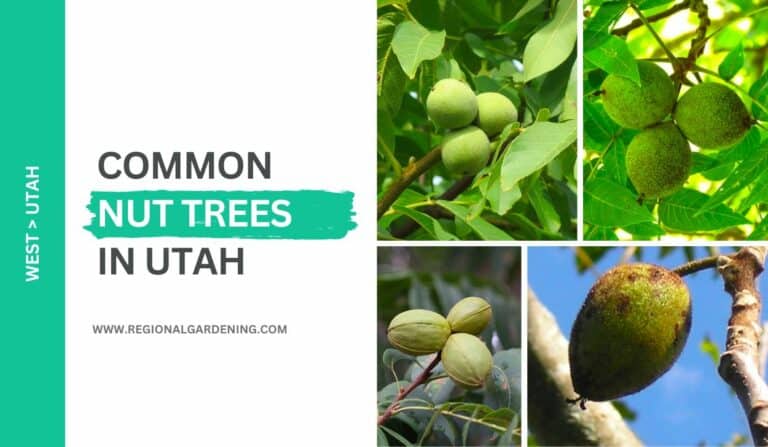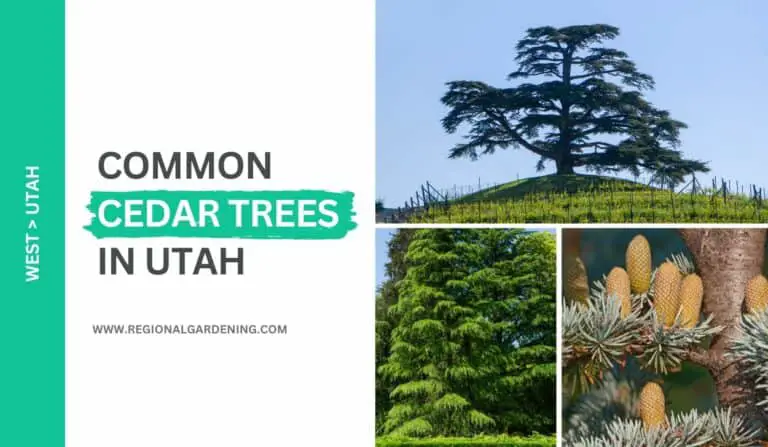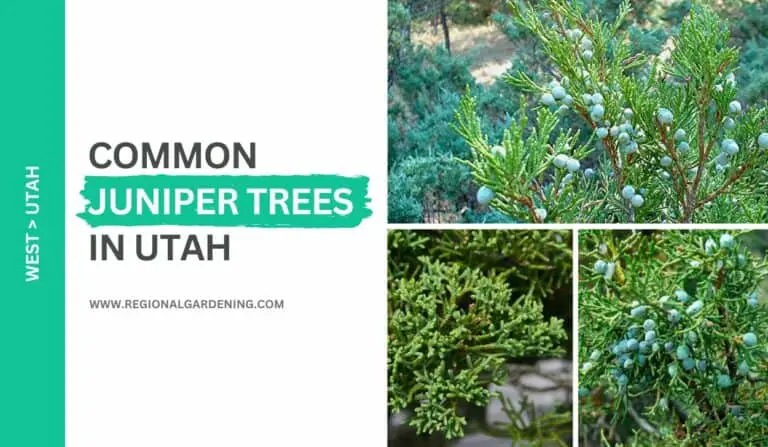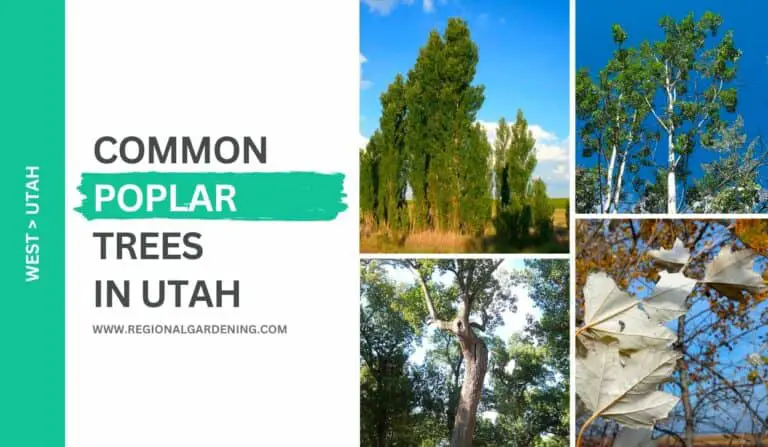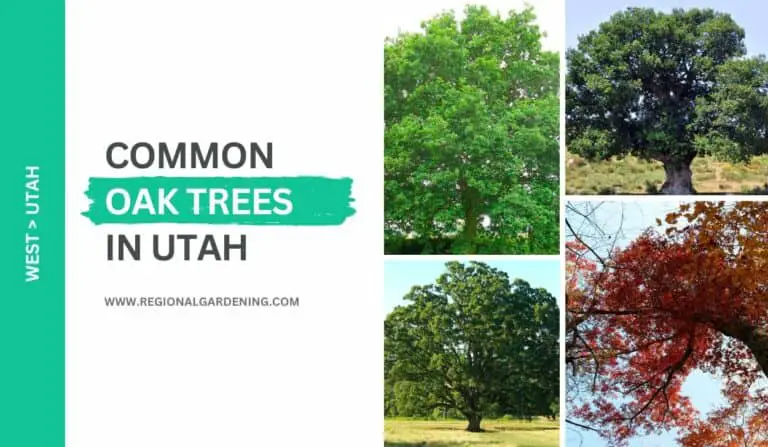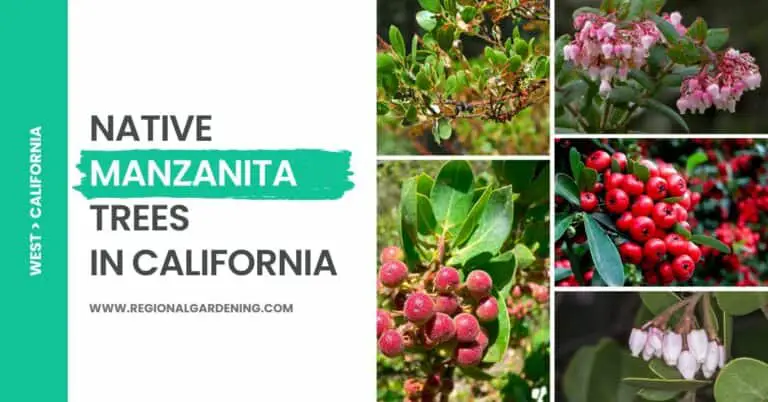4 Types Of Cedar Trees In California (Pictures & Identification)
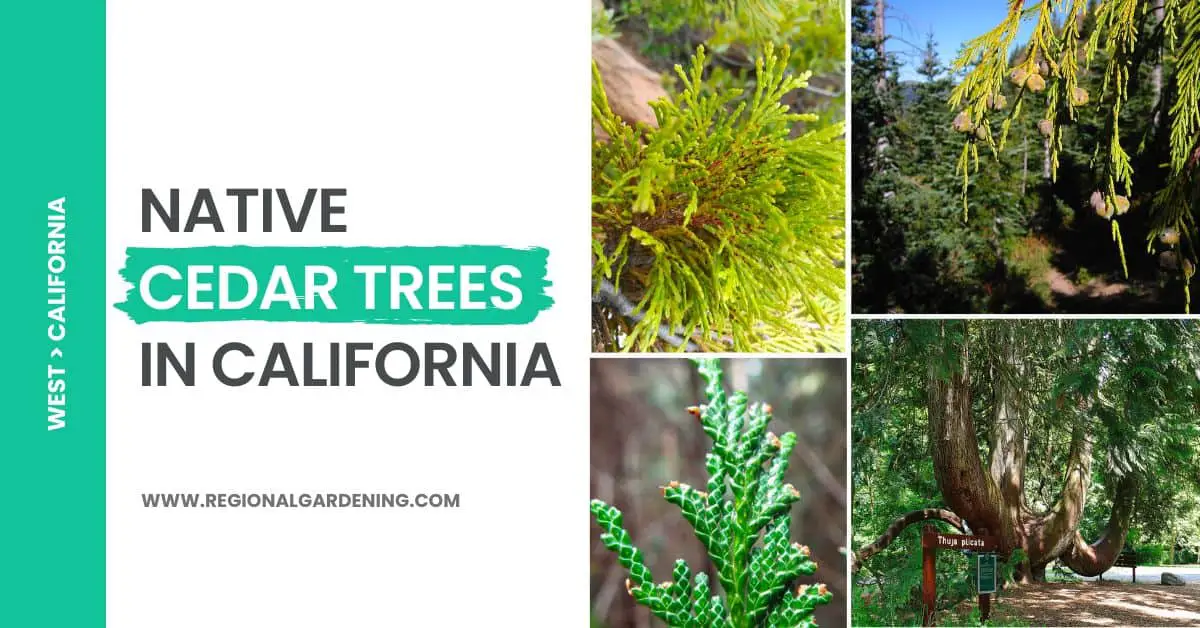
California is recognized for its various landscapes and abundance of flora and animals, and cedar trees are a vital component of this rich natural legacy. However, not all cedar trees in California are native to the region, and it is essential to distinguish between native and non-native species based on their ecological and cultural relevance.
This article focuses on the four varieties of native cedar trees in California forests and landscapes. Each tree’s descriptions include its physical qualities and its vital function in the state’s ecosystems.
Each native cedar species, from the stately Incense cedar to the delicate Port Orford cedar, possesses distinctive characteristics that make it worthy of appreciation and protection.
1. Incense Cedar
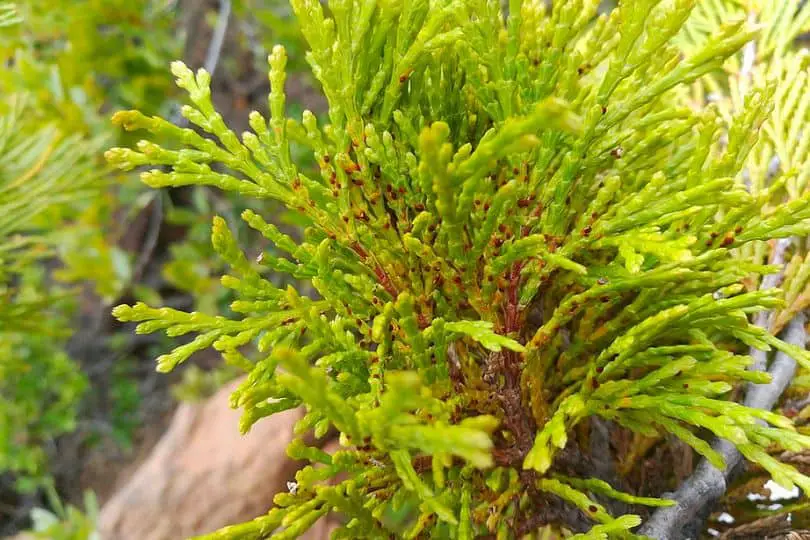
- Scientific Name: Calocedrus decurrens
- Common Name(s): Incense Cedar, California Cedar, White Cedar
- Mature Height: 40-100ft
- Flowers: Cones
- Uses: Interior paneling, Window sashes, etc.
The incense cedar tree is one of the first trees to be mentioned in the list of native cedar trees in California. It’s a single-stemmed, tall tree with fluted bases and full, rounded crowns.
The leaves are scalelike, with blunt tips and a yellowish-green color. Additionally, they have the appearance of the outline of a pilsner beer glass or a wine glass. The cones are up to 31 millimeters in length, have three sets of fused scales, and have a leathery cinnamon-brown color.
The bark on fully grown trees can be up to 15 centimeters thick and fibrous, with a cinnamon-brown color.
The range of the incense-cedar tree extends from northern Oregon to Baja California in Mexico, and it is found in a variety of mixed coniferous forests and woodlands.
They typically thrive in the 45 m to 3000 m altitude range, making California their preferred growing region. The Incense-cedar tree not only looks pretty in California’s woods, but it also serves a few practical purposes.
This wood can be used outside without fear of rot. Incense cedar is also used to make most wooden pencils because it can be sharpened at any angle without splitting. However, due to its thin, flammable bark, this tree is highly vulnerable to fire.
2. Port Orford-Cedar
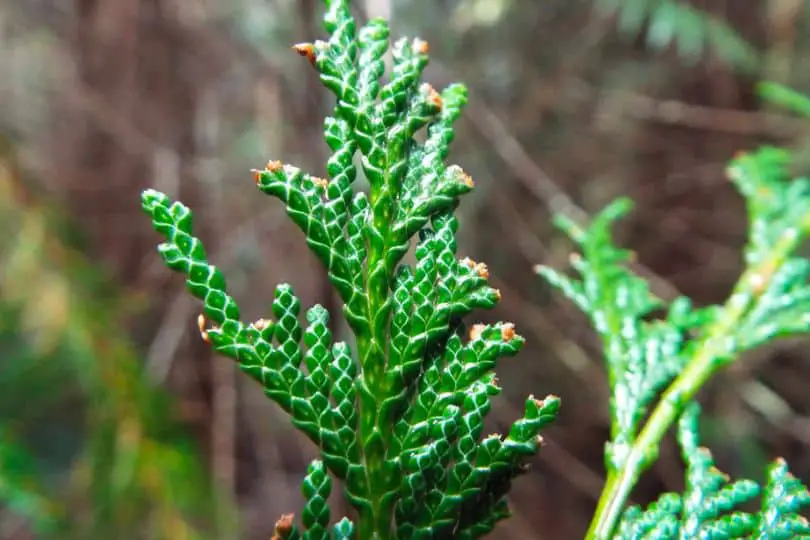
- Scientific Name: Chamaecyparis lawsoniana
- Common Name(s): Lawson’s cypress, Port Orford cedar
- Mature Height: 125-180ft
- Flowers: Cones
- Uses: Ornamental purposes, musical instruments.
One of the commonly seen native cedar trees in California, the Port Orford-cedar is a tall, erect, single-stemmed tree found in coastal and montane coniferous forests in southwestern Oregon and northwestern California.
Some of the largest specimens in the Siskiyou National Forest are 67 m (219 ft) in height and 3.6 m (12 ft) in diameter, but the average height and diameter range from 38 m (125 ft) to 55 m (180 ft) and 90 cm (3 ft) to 180 cm (6 ft), respectively.
In addition to a lifespan of over 500 years, members of this species are characterized by swollen butts and long, transparent stems that end in conical crowns.
The Port Orford cedar can survive in partially shaded areas and has a thick, grayish-brown, fibrous, and deeply furrowed bark that makes it resistant to fire. However, Phytophthora lateralis, a fungal disease that can be accidentally spread by mud on vehicles or boots, poses the greatest threat by causing root rot.
Despite this danger, the wood of the Port Orford-cedar is highly sought after in Asia, where it is used by boat builders, woodworkers, and casket makers due to its pungent, ginger-like aroma and resistance to rotting.
3. Alaska Yellow-Cedar
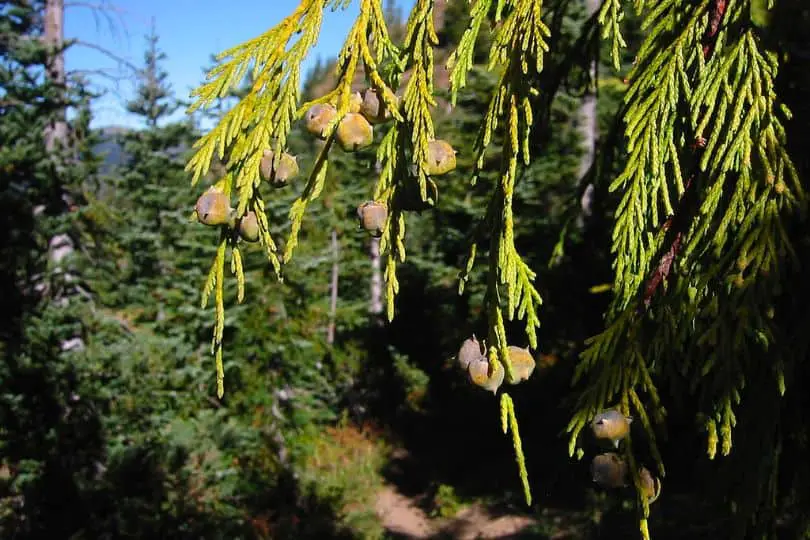
- Scientific Name: Chamaecyparis nootkatensis
- Common Name(s): Yellow Cedar, Alaska Cypress, Nootka Cypress
- Mature Height: 65-100ft
- Flowers: Cones
- Uses: Boat construction, furniture, paneling, etc.
The Alaska yellow-cedar, scientifically known as Chamaecyparis nootkatensis, is a medium-sized, single-stemmed tree that can also grow in shrub forms near the tree line in the Northwest and at lower elevations in California.
Mature trees can grow to be 20 m (65 ft) to 30 m (100 ft) tall and 60 cm (2 ft) to 120 cm (4 ft) in diameter, with the largest specimen growing in Olympic National Park measuring 38 m (124 ft) tall and 3.6 m (12 ft) in diameter.
The species is known for its droopy branches with loosely hanging, flat leaf sprays and can live for more than 1,000 years, with one tree estimated to be 3,500 years old. The base of the tree is buttressed, and the crown is conical.
The leaves are scalelike, bluish-green when young, and yellowish after 2 or 3 years, with a length of about 3 mm (.12 in.). The cones are woody and spherical, and range in size from 6 mm (.25 in.) to 12 mm (.5 in. ), with immature cones resembling small soccer balls.
The bark is grayish-brown and thin, with shallow furrows. From south-central Alaska to northwestern California, the Alaska yellow-cedar grows in coastal, montane, and subalpine coniferous forests, with elevations ranging from sea level in Alaska to 2,300 m (7,500 ft) in the Cascades.
It is not among the commonly seen native cedar trees in California. Instead, they only grow in isolated stands in the Siskiyou Mountains. It thrives in cold, wet habitats with abundant winter snow, and can be found growing on rocks with no visible soil as well as better-drained, moist soils.
Alaska yellow-cedar wood is rot-resistant and easy to work, and it is used in boats, saunas, and moldings.
4. Western Redcedar
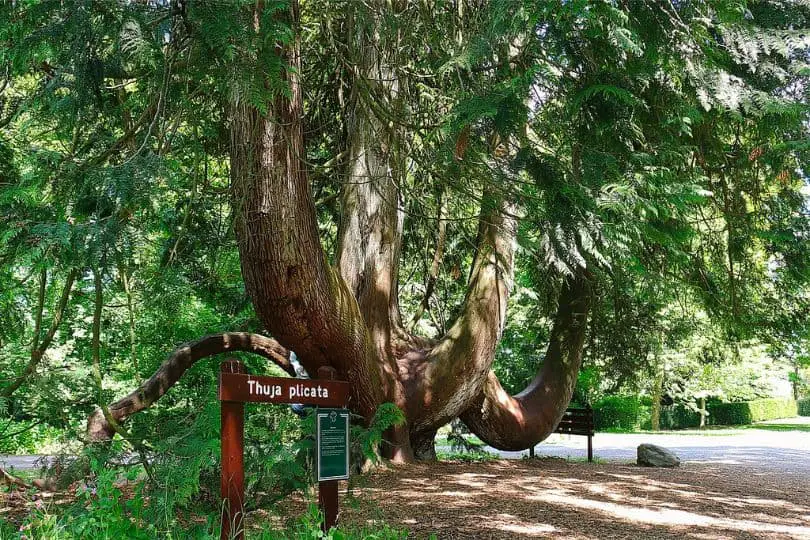
- Scientific Name: Thuja plicata
- Common Name(s): Yellow Cedar, Alaska Cypress, Nootka Cypress
- Mature Height: 65-100ft
- Flowers: Cones
- Uses: Leavers have medicinal properties.
The Western Redcedar, scientifically known as Thuja plicata, is a tall and erect tree with long, clear trunks and full, rounded crowns.
From Alaska to northwestern California, including western Montana and Idaho, you can find this plant flourishing in coastal and montane coniferous woods. It grows from sea level up to 2,100 m (7,000 ft) and needs lots of water.
Western redcedar leaves are alternately arranged and have a scalelike shape with blunt tips. Cones are around 12 millimeters (.5 inches) in length, are leathery, stand upright, and are a dark brown color. Mature trees have cinnamon-brown bark that is thin, fibrous, and furrowed.
Western Redcedar is one of the longest-living native cedar trees in California that can live for over 1000 years. It may grow in partial shade but has a high risk of being burned because of its papery bark, weak roots, and combustible leaves.
Besides timber, shakes, shingles, and paneling are among the prominent uses for this species. This material was crucial to the construction of totem poles, canoes, and even homes for the indigenous people of North America.
Historically, its bark has been woven into rope and used to sew textiles. Numerous bird and small animal species rely on the Western Redcedar’s leaf for shelter and food. It is also grown for its ornamental value and its utility as a hedge when kept in check.
Native Cedar Trees In California – Frequently Asked Questions (FAQs)
Here are some of the most commonly asked questions on the internet about native cedar trees in California.
What kind of cedar trees grow in California?
The commonly grown cedar trees in California are Incense-cedar and Port Orford Cedar. However, certain regions of the state have an abundant population of both Alaska Yellow Cedar and Western Redcedar.
Are Western Redcedar and Alaska yellow-cedar, real cedar trees?
Both Western red-cedar and Alaska yellow-cedar are not true cedars. The western red cedar is arborvitae while the Alaska yellow cedar is a variant of the cypress family.
Similar Articles
- Native Maple Trees In California
- Native Oak Trees In California
- Native Cypress Trees In California
- Native Birch Trees In California
- Native Spruce Trees In California
- Native Manzanita Trees In California
- Native Hemlock Trees In California
- Native Alder Trees In California
- Native Fir Trees In California
- Common White Bark Trees In California
- Native Juniper Trees In California
- Native Ash Trees In California
- Common Purple Trees In California
Sources
The Regional Gardening team makes sure that the information in our articles is accurate by only using sources that are known to be trustworthy. Some of these sources are peer-reviewed journals from government agencies, well-known universities, and scientific research organizations.
- California Forests, University Of California
- California Native Plant Society
- Native Plants, California Department Of Fish & Wildlife
- California Natural Diversity Database


